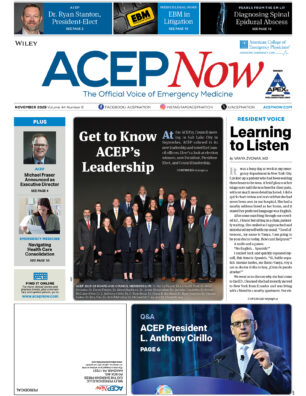Each day, dramatic stories of lifesaving interventions unfold in emergency departments. Following the deadly shooting rampage in Tucson in 2011, the successful outcome for Arizona Congresswoman Gabrielle Giffords catalyzed a positive change in perception in Washington about the nation’s trauma and emergency workforce. Congress and the White House have recognized the strength of our country’s emergency medical services and the importance of sustaining it. The time has arrived for our profession to lead the way in resolving the challenges of ED overcrowding, the “boarding” of patients awaiting hospital admission, ambulance diversion, and the national shortage of surgeons willing to take call.
Explore This Issue
ACEP News: Vol 31 – No 08 – August 2012Surgeons’ reluctance to take emergency call is entirely understandable; emergency surgical patients have a higher mortality rate than do nonemergent patients, litigation risks and malpractice premiums have increased, and a surgeon’s quality of life is adversely affected. Yet, it is also a privilege and an honor to take call, and the need for emergency surgical care reflects the trust that society places in emergency and trauma surgeons to deliver high-quality, optimal care.
Ultimately, identifying ways to support those physicians who are willing to place themselves on the front lines of clinical care will be instrumental in solving the emergency care crisis.
A key challenge is to better match patients’ needs with available surgical services. The current reimbursement system often rewards elective procedures over emergent ones. And because hospitals are often filled with patients recuperating from elective procedures, those in need of emergent procedures sometimes aren’t admitted in a timely manner (N. Engl. J. Med. 2011;364:2279-81). But the emergency care crisis can likely be solved through better distribution and prioritization of resources and incentives, and by standardizing and coordinating care nationally.
In 1993, Dr. Michael Johns, now chancellor of Emory University, Atlanta, proposed the creation of a mandatory National Health Service Corps (JAMA 1993;
269:3156-7) to adequately distribute physicians across America. The proposal was not adopted, and existing Title VII and VIII programs of the Public Health Service Act evolved to focus instead on increasing the primary care workforce. Over the past year, however, interest in a voluntary General Surgery NHSC to deploy board-certified general and trauma surgeons across rural America has reemerged.
Successful implementation of a General Surgery NHSC will require three steps:
- Accurately identify where newly credentialed NHSC surgeons should be assigned.
- Undertake a national inventory of the resources (manpower, hospital facilities, time, capital) that can be reallocated.
- Determine ways to create incentives for surgeons who are willing to relocate.
Nearly 20 years have elapsed since the creation of a General Surgery NHSC was first proposed. The time has arrived for the promise of an NHSC to be fulfilled. A broad, visionary, federal approach of regionalized emergency care institutions staffed by specialists in emergency care could transform and strengthen the emergency surgery delivery system. Until then, our nation should recognize the courage and heroism of its emergency care workforce that each and every day strives to meet greater societal needs and defend patients from permanent disability and death.
Dr. Maa is an assistant professor in the department of surgery at the University of California, San Francisco.
Pages: 1 2 | Multi-Page




No Responses to “Solving the Emergency Surgical Care Crisis”